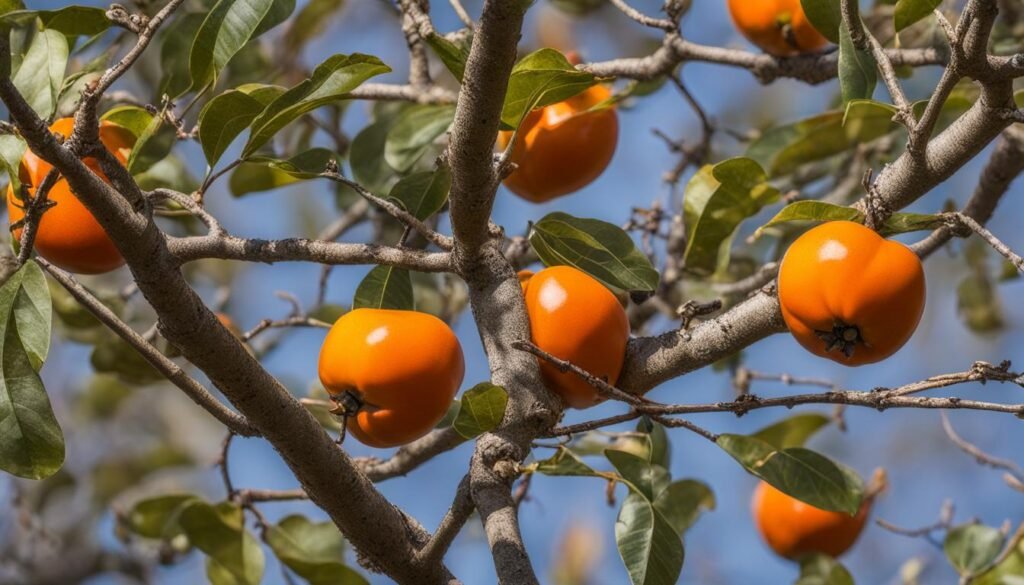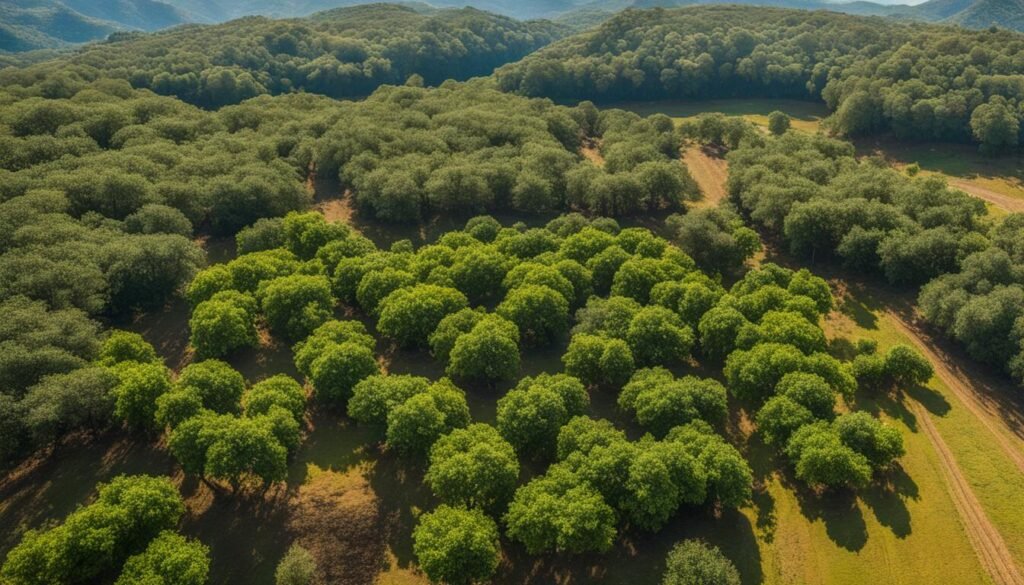Hello there! Today, I want to take you on a journey to explore the incredible benefits that persimmon trees bring to ecosystems. These trees, known for their delicious fruit, offer so much more than just a tasty treat. Let’s dive into the world of persimmon tree ecosystem benefits and discover why they are truly marvelous.
Key Takeaways:
- Persimmon trees attract pollinators and provide a valuable food source for wildlife, enhancing biodiversity in ecosystems.
- These trees offer environmental benefits such as air quality improvement, soil erosion prevention, and water absorption enhancement.
- Persimmons have economic value, with their fruit being a potential source of income and their timber used for various products.
- They possess medicinal and nutritional benefits, containing antioxidants, vitamins, and dietary fiber.
- Persimmon trees support sustainable agriculture practices, requiring minimal pesticide use and attracting beneficial insects.
The Beauty of Persimmon Tree Ecosystem
Persimmon trees enhance the beauty and diversity of ecosystems. Their vibrant green leaves and clusters of yellow or creamy white flowers add visual interest to the landscape. These flowers attract a variety of pollinators, including honeybees, bumblebees, and various species of native bees.
The fruit of the persimmon tree provides a valuable food source for wildlife, including birds, mammals, and insects. By incorporating persimmon trees into ecosystems, we can create a more diverse and thriving environment. The sweet and succulent fruit attracts birds such as wild turkeys, cedar waxwings, and robins, which rely on persimmons for sustenance. Mammals like raccoons, foxes, and black bears also feed on the fruit, while squirrels and deer consume both the fruit and leaves.
The beauty of the persimmon tree ecosystem lies not only in its visual appeal but also in its ability to support and sustain a wide range of wildlife. By providing a habitat and a source of nourishment, persimmon trees contribute to the overall health and balance of the ecosystem.
Exploring Persimmon Tree Ecosystem Benefits
As persimmon trees attract pollinators and provide food for wildlife, they play a critical role in maintaining biodiversity. They help create a rich and varied ecosystem by attracting a diverse range of species, from insects to birds and mammals. This diversity is not only aesthetically pleasing but also essential for the overall health and resilience of the ecosystem.
Moreover, the presence of persimmon trees in ecosystems can also have indirect benefits. The trees offer shade and shelter for other plants and animals, creating microhabitats within the larger ecosystem. They contribute to soil health by preventing erosion and improving water absorption, which helps maintain the balance of nutrients in the soil.
By recognizing the importance of persimmon tree ecosystems and promoting their inclusion in our landscapes, we can ensure the preservation and enhancement of biodiversity in our natural environments. Let us appreciate the beauty and value that persimmon trees bring to our ecosystems and work towards their protection and conservation.

Table: Wildlife Supported by Persimmon Trees
| Animal | Role in Ecosystem |
|---|---|
| Birds (wild turkeys, cedar waxwings, robins) | Seed dispersal through feces |
| Mammals (raccoons, foxes, black bears) | Seed dispersal through feces, pollination |
| Squirrels and deer | Seed dispersal, leaf and fruit consumption |
| Insects (honeybees, bumblebees, native bees) | Pollination, insect food source |
The table above shows some of the key wildlife species supported by persimmon trees and their roles in the ecosystem. By providing food and habitat for these animals, persimmon trees contribute to the overall balance and functioning of the ecosystem.
Ecosystem Benefits of Persimmon Trees
Persimmon trees offer numerous benefits to ecosystems, contributing to their overall health and vitality. By understanding the benefits of a persimmon tree ecosystem, we can appreciate the value these trees bring to our natural surroundings.
Improved Air Quality and Soil Erosion Prevention
One of the significant environmental benefits of persimmon trees is their ability to improve air quality. Through their leaves, persimmon trees filter pollutants from the air and release oxygen, helping to create cleaner and fresher surroundings.
Additionally, the deep and extensive root system of persimmon trees plays a crucial role in preventing soil erosion. These roots help anchor the soil, reducing the risk of erosion caused by wind or water. By maintaining the integrity of the soil, persimmon trees contribute to the overall stability of ecosystems and protect against the damaging effects of erosion and runoff.
Enhanced Biodiversity and Habitat Creation
Persimmon trees attract a variety of pollinators, contributing to the overall biodiversity of ecosystems. Their vibrant flowers and sweet fruit provide an abundant food source for bees, butterflies, and other pollinating insects. By attracting these important pollinators, persimmon trees support the reproduction and survival of various plant species, ensuring the continuation of diverse habitats.
Furthermore, the fruit of the persimmon tree serves as a valuable food source for wildlife, including birds, mammals, and insects. The presence of persimmon trees in ecosystems provides nourishment for these animals and contributes to the overall balance and health of the ecosystem.
Conclusion
The environmental benefits of persimmon trees are manifold. From improving air quality and preventing soil erosion to enhancing biodiversity and creating habitats, these trees play a vital role in maintaining the health and balance of ecosystems. By understanding and appreciating the benefits of a persimmon tree ecosystem, we can cultivate a greater sense of stewardship for these remarkable trees and the environments they contribute to.

Having persimmon trees in ecosystems not only provides essential nourishment for wildlife but also creates a harmonious balance within the natural environment.
By including persimmon trees in our landscapes, we can create a haven for wildlife, ensuring their survival and enhancing the overall health of our ecosystems. The presence of these trees supports a thriving and diverse community of animals, contributing to the ecological richness of our surroundings. Persimmon trees offer an exceptional opportunity for individuals and communities to make a positive impact on wildlife conservation.
Incorporating Persimmon Trees in Urban Landscapes
In addition to their benefits in natural ecosystems, persimmon trees can also play a significant role in urban landscapes. By planting these trees in parks, gardens, and other green spaces within cities, we provide urban wildlife with a valuable food source and create opportunities for biodiversity even in highly developed areas. The presence of persimmon trees can attract a variety of bird species, adding beauty and wildlife habitat to urban environments.
- Attract birds to urban landscapes
- Enhance biodiversity in cities
- Create wildlife habitat in urban areas
Persimmon trees offer a win-win solution for both wildlife and urban dwellers, providing beauty, biodiversity, and a connection to nature in our cities.
Economic Benefits of Persimmon Trees
When it comes to the advantages of the persimmon tree ecosystem, the economic benefits are not to be overlooked. Cultivating persimmon trees not only contributes to the ecological health of ecosystems, but it also offers opportunities for communities and individuals to thrive economically. One of the main economic benefits of persimmon trees is the potential income they can generate through fruit harvesting and sales. The delicious and sought-after persimmon fruit can be harvested and sold, providing a valuable source of revenue for farmers and local businesses.
Furthermore, the timber of the persimmon tree has a long history of being used for various products, including the manufacturing of golf club heads. The dense and durable wood of the persimmon tree makes it ideal for crafting high-quality golf clubs. This industry has created employment opportunities and contributed to the local economy in areas where persimmon trees are abundant. By cultivating persimmon trees, we can stimulate local economies, support small businesses, and create sustainable livelihoods.

Whether you’re looking to incorporate more nutritious foods into your diet or simply enjoy the incredible taste of persimmons, adding them to your landscape can provide you with a sustainable source of this remarkable fruit. With their multitude of health benefits and delectable flavor, persimmons are truly a treasure worth exploring within the persimmon tree ecosystem.
Supporting Sustainable Agriculture with Persimmon Trees
Persimmon trees can play a crucial role in supporting sustainable agriculture practices. Their low-maintenance nature and minimal pesticide requirements make them an ideal choice for organic farming. Additionally, intercropping persimmon trees with other crops can provide shade and wind protection, creating a more favorable microclimate for crop growth. This integration of persimmon trees into agricultural systems not only promotes sustainability but also reduces the environmental impact of farming.
One of the key benefits of incorporating persimmon trees into agriculture is their ability to attract beneficial insects. These insects act as natural pest control agents, reducing the need for chemical pesticides. By creating a habitat that supports a diverse range of insect populations, persimmon trees contribute to the ecological balance of agricultural ecosystems.
Benefits of Persimmon Trees in Sustainable Agriculture
- Low-maintenance and minimal pesticide use.
- Intercropping provides shade and wind protection.
- Attracts beneficial insects for natural pest control.
- Reduces reliance on chemical pesticides.
- Contributes to a more sustainable and environmentally-friendly farming system.
In addition to the ecological advantages, persimmon trees offer economic benefits to farmers and local communities. The fruit can be harvested and sold, creating a potential source of income. Furthermore, the cultivation of persimmon trees can stimulate local economies and create employment opportunities, contributing to the economic sustainability of agricultural regions.
By embracing persimmon trees as a sustainable agricultural practice, we can not only protect and enhance the health of our ecosystems but also support the livelihoods of farmers and promote economic growth. Together, we can build a more sustainable and resilient future for agriculture and the environment.

Moreover, persimmon trees can thrive in a variety of climates, making them adaptable to changing weather patterns. With their ability to withstand drought conditions and fluctuating temperatures, persimmon trees can continue to thrive and provide their valuable benefits even in the face of climate uncertainties.
Climate Change Resilience Comparison
| Persimmon Trees | Other Tree Species | |
|---|---|---|
| Carbon sequestration | High | Variable |
| Heat mitigation | Effective | Variable |
| Drought tolerance | High | Variable |
| Temperature adaptability | High | Variable |
When comparing persimmon trees to other tree species in terms of climate change resilience, we can see that persimmon trees excel in several key areas. Their high carbon sequestration capacity, effective heat mitigation, and ability to tolerate drought and adapt to various temperatures make them a standout choice for supporting climate change mitigation efforts. By incorporating persimmon trees into our landscapes and urban areas, we can contribute to a more resilient and sustainable environment.
Conservation and Restoration of Persimmon Tree Ecosystems
The conservation and restoration of persimmon tree ecosystems are of paramount importance for preserving biodiversity and ensuring the continued benefits they provide. By protecting existing persimmon tree habitats and promoting the planting of new trees, we can contribute to the overall health and sustainability of our ecosystems.
Persimmon trees play a vital role in supporting a wide range of wildlife, providing a valuable food source for birds, mammals, and insects. They also attract pollinators, contributing to the overall biodiversity of the ecosystem. By conserving and restoring persimmon tree ecosystems, we can help sustain these populations and maintain the delicate balance of our natural environments.
Persimmon Tree Conservation: A Collaborative Effort
Conservation efforts for persimmon tree ecosystems require a collaborative approach involving various stakeholders, including local communities, landowners, conservation organizations, and government agencies. By working together, we can implement effective strategies to protect and restore persimmon tree habitats.
Restoration projects can involve planting persimmon trees in degraded landscapes, creating habitat corridors, and engaging local communities in conservation efforts. These initiatives not only help preserve the persimmon tree species but also contribute to the overall health and resilience of the surrounding ecosystem.
Education and Awareness: Promoting the Importance of Persimmon Tree Ecosystems
Increasing public awareness about the benefits of persimmon tree ecosystems is essential for their conservation and widespread adoption. By educating the public about the ecological, economic, and nutritional value of persimmons, we can inspire individuals to incorporate these trees into their own landscapes.
Through educational programs, workshops, and outreach initiatives, we can disseminate information about persimmon tree ecosystem benefits and encourage sustainable practices. By promoting knowledge and understanding of the importance of persimmon tree ecosystems, we can foster a greater appreciation and stewardship of these valuable resources.

| Benefits of Conservation and Restoration | Actions |
|---|---|
| Preservation of biodiversity | Protecting existing persimmon tree habitats |
| Support for wildlife populations | Promoting the planting of new persimmon trees |
| Environmental resilience | Engaging in restoration projects |
| Community involvement | Collaborating with local communities |
Education and Awareness about Persimmon Tree Ecosystem Benefits
As we explore the remarkable benefits of persimmon tree ecosystems, it is crucial to increase education and awareness about their value. By understanding the ecological, economic, and nutritional advantages they offer, we can inspire individuals to incorporate persimmon trees into their own landscapes and contribute to the preservation of these unique ecosystems.
One way to promote education and awareness is through interactive programs and workshops. These initiatives can provide hands-on experiences, allowing participants to learn about the benefits of persimmon trees firsthand. Workshops can cover topics such as cultivation techniques, the importance of pollinators, and the role of persimmon trees in supporting wildlife populations.
Outreach efforts can also be an effective tool for disseminating information about persimmon tree ecosystem benefits. Through community events, informational brochures, and online platforms, we can reach a wider audience and share the importance of persimmon trees in maintaining biodiversity and supporting sustainable practices.
By fostering knowledge and understanding, we can cultivate a greater appreciation for the value of persimmon tree ecosystems. This awareness can lead to the widespread adoption of these trees and the creation of sustainable landscapes that benefit both nature and society.
Key Points:
- Promoting education and awareness about persimmon tree ecosystems is essential.
- Interactive programs and workshops can provide hands-on experiences to learn about the benefits of persimmon trees.
- Outreach efforts through community events and online platforms can help disseminate information.
- Increasing knowledge and understanding can lead to the widespread adoption of persimmon trees and the creation of sustainable landscapes.

| Benefit | Description |
|---|---|
| Ecological | Persimmon trees attract pollinators, contribute to biodiversity, and filter pollutants. |
| Economic | The fruit can be harvested and sold, stimulating local economies and creating job opportunities. |
| Nutritional | Persimmons are rich in antioxidants, vitamins, and dietary fiber, promoting a healthy diet. |
| Environmental | Persimmon trees help prevent soil erosion, improve air quality, and absorb water, reducing flooding risks. |
| Wildlife | Persimmon trees provide a valuable food source for birds, mammals, insects, and contribute to supporting wildlife populations. |
| Sustainable Agriculture | Persimmon trees can be grown organically, require minimal pesticide use, and attract beneficial insects for natural pest control. |
| Climate Change Resilience | Persimmon trees help sequester carbon, reduce urban heat island effects, and contribute to climate change mitigation efforts. |
| Conservation and Restoration | Protecting and restoring persimmon tree habitats is essential for preserving biodiversity and maintaining ecosystem health. |
Conclusion
As I conclude this exploration of persimmon tree ecosystems, it’s evident that these trees offer a multitude of benefits to both nature and society. Their ability to attract pollinators and provide a valuable food source for wildlife contributes to the biodiversity and health of ecosystems. Additionally, persimmon trees offer economic advantages, from the sale of their fruit to the use of their timber in various products.
Furthermore, persimmons themselves are a nutritional powerhouse, packed with antioxidants, vitamins, and fiber, offering numerous health benefits. By incorporating persimmon trees into our landscapes, we can promote sustainable agriculture practices, support climate change resilience, and contribute to conservation and restoration efforts.
It is vital to raise awareness about the advantages of persimmon tree ecosystems, inspiring individuals to embrace their marvel and incorporate these trees into their own environments. By harnessing the benefits of persimmon tree ecosystems, we can create thriving landscapes that benefit our environment, communities, and future generations. Let us recognize the significance of persimmon tree ecosystem benefits and work towards transforming our world in a positive way.
FAQ
Can I grow persimmon trees in Michigan?
Yes, persimmon trees can be grown in Michigan. Despite their initial reputation as a southern fruit, persimmon trees are actually relatively easy to grow in Michigan.
How do I achieve optimal ripeness for persimmons?
Persimmons can be challenging to ripen, but there are special methods you can use to achieve optimal ripeness. For example, placing the fruit in a paper bag with a ripe banana can help speed up the ripening process.
What wildlife does persimmon fruit attract?
Persimmon fruit attracts a variety of wildlife, including birds such as wild turkeys, cedar waxwings, and robins, as well as mammals like raccoons, foxes, and black bears. Squirrels and deer also consume both the fruit and leaves.
What are the health benefits of persimmons?
Persimmons are a rich source of antioxidants, vitamins A and C, and dietary fiber. They contribute to a healthy immune system, promote healthy vision, aid in digestion, and have anti-inflammatory properties.
How do persimmons benefit sustainable agriculture?
Persimmon trees are relatively low-maintenance and require minimal pesticide use, making them a viable option for organic farming. They can be intercropped with other crops, provide shade and wind protection, and attract beneficial insects for natural pest control.
How can persimmon trees contribute to climate change resilience?
Persimmon trees have deep root systems that can help sequester carbon from the atmosphere, mitigating the effects of climate change. They also provide shade, which can help reduce urban heat island effects and provide a cooling effect in warmer climates.
What can I do to help conserve and restore persimmon tree ecosystems?
You can help conserve and restore persimmon tree ecosystems by protecting existing habitats, planting new trees in degraded landscapes, creating habitat corridors, and engaging in local community conservation efforts.
How can I promote education and awareness about persimmon tree ecosystem benefits?
You can promote education and awareness about persimmon tree ecosystem benefits by participating in educational programs, workshops, and outreach initiatives that share information about the ecological, economic, and nutritional value of persimmons.
Are persimmons suitable for selling and commercial use?
Yes, persimmons can be harvested and sold, providing a potential source of income for farmers and local businesses. The timber of the persimmon tree has also been historically used for making products such as golf club heads.
How do persimmon trees benefit ecosystems aesthetically?
Persimmon trees enhance the beauty of ecosystems with their vibrant green leaves and clusters of yellow or creamy white flowers. These flowers attract pollinators and add visual interest to the landscape.
Why should I incorporate persimmon trees into ecosystems?
Incorporating persimmon trees into ecosystems helps promote biodiversity by attracting pollinators, providing a food source for wildlife, improving air quality, preventing soil erosion, and offering economic and health benefits.




